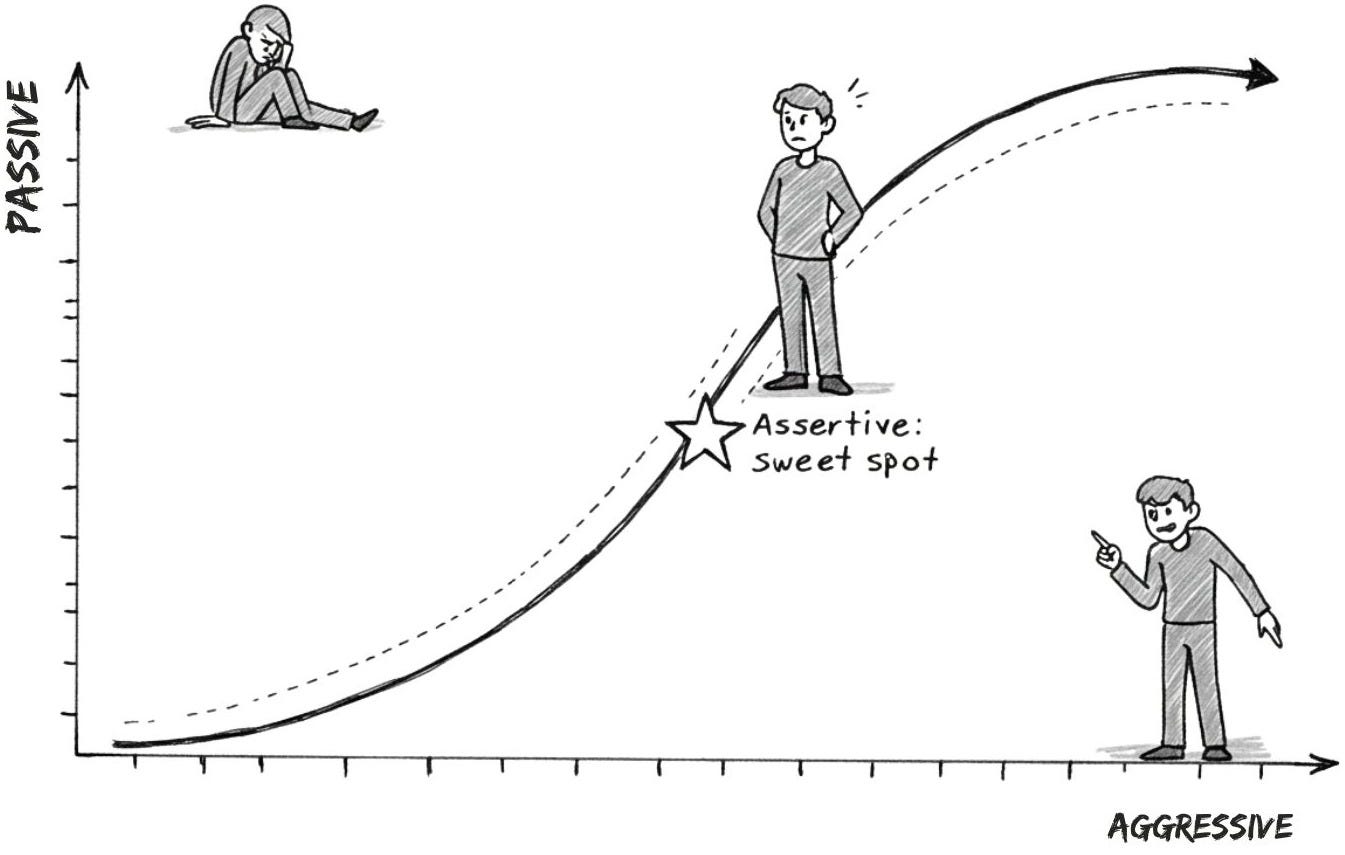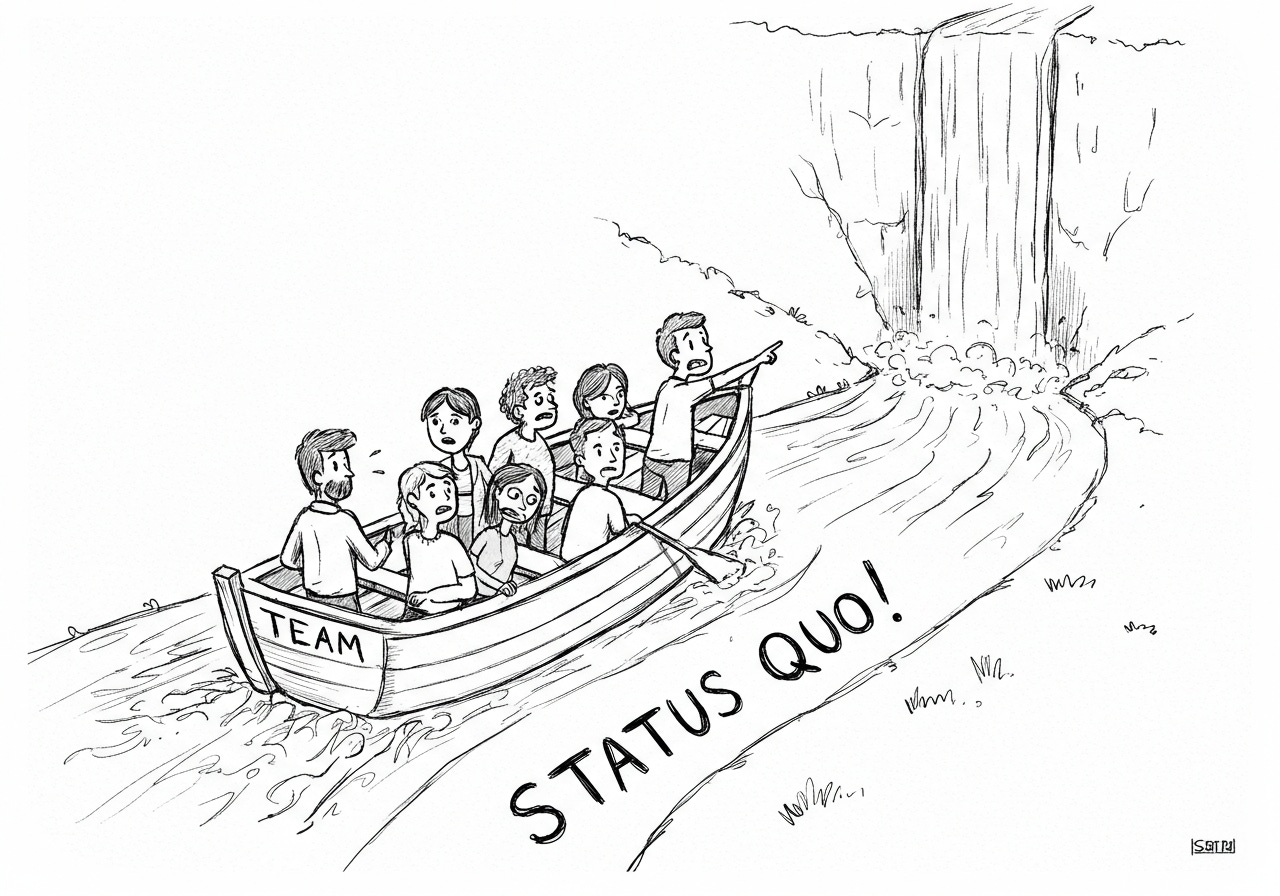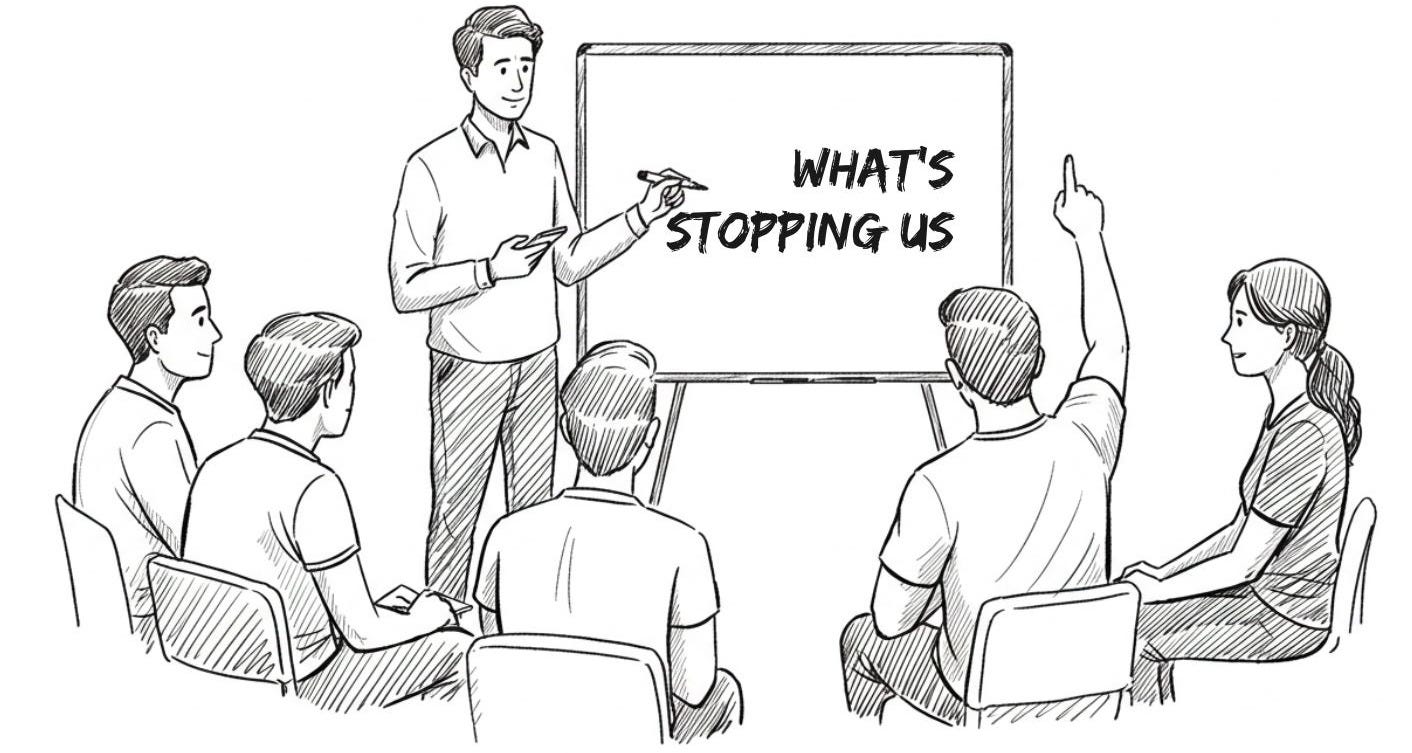Welcome to the 🔥 free edition 🔥 of Winning Strategy: A newsletter focused on enhancing product, process, team, and career performance. If you’d like to become a paid member, please see the benefits here, and feel free to use this expense template to request approval from your manager.
I've been leading teams for years, and if there's one skill I wish I'd mastered early in my career, it's Assertiveness.
The post title says it’s an essential skill… It’s not merely that.
It's the make-or-break factor for someone who really wants to help their team AND themselves succeed.
I once had this brilliant team, full of potential, but they missed opportunities because their leader (that’s me) was too afraid to step up and say what needed to be said.
It was frustrating and, honestly, a total waste of everyone's talent.
Mastering Assertiveness allowed me to cut through the BS and improved my team’s chances of succeeding.
“So why aren't more people doing this?”
Because they think that being Assertive will come across as pushy. They confuse Assertiveness with being a bully.
THIS IS NOT THE CASE!
Assertiveness is straightforward, powerful stuff.
It boils down to two things I live by:
speaking your mind with confidence, and
commanding respect “without” being mean (this is important) to people
Nothing more. Nothing less.
If you are missing this skill, you're probably not leading as effectively as you could be.
In this post, I'll share my take on:
What assertiveness really means
7 communication tricks I've been using to be Assertive
Let’s get started.
If you’re new, here’s what you missed
Got an urgent question?
Get a quick answer by joining the subscriber chat below.
What assertiveness really means
Let’s start with what Assertiveness is NOT.
Assertiveness is not being the loudest voice in the room or the quietest. It’s not steamrolling people. Also it is not rolling over and playing dead.
NO!
Assertiveness is the CONFIDENT and DIRECT expression of your thoughts while still showing respect for everyone else.
As a new Scrum Master, I thought I had two options:
Speak up and push my way through disagreements (aggressive), or
Keep the peace at all costs, even if it meant biting my tongue (passive)
Neither worked.
Both approaches left me frustrated and misunderstood,
When you say 'yes' to others, make sure you are not saying 'no' to yourself.
- Paulo Coelho
Assertiveness is somewhere in the middle.
When you are Passive:
You nod along, avoid conflict, and let others’ needs always take priority. You walk away from conversations thinking, “Why didn’t I say what I really meant?”
When you are Aggressive:
You push, you interrupt, you maybe even intimidate people into agreeing. You get your way, but at the cost of trust and team spirit.
When you are Assertive (the sweet spot):
You speak up. You’re honest, direct, but also calm. You set boundaries and say what needs to be said, without turning it into a showdown.
It takes courage… no doubt. But you do it anyway.
One of the most courageous things you can do is to speak up for yourself. Not because you are guaranteed to win, but because you embrace the truth.
- Maya Angelou
Examples:
Assertiveness is standing up for what is right. It’s:
Positive
Respectful
Honest
Straightforward, and
Calm
When you find this sweet spot, people start listening to you, and you start to influence people (no authority needed).
How do you develop this skill?
With Practice...
I know, it sounds like the most clichéd advice ever. Hear me out though.
In the world of Scrum Mastering, Assertiveness is not a superpower you either have or you don't.
It is a skill you build, one stand-up or retrospective at a time.
It needs:
repetition,
courage, and
a willingness to screw up and try again
I remember when I was learning to be assertive with my team. My voice used to shake a little. It wasn't very comfortable. But it worked better than staying silent.
The next time, it was easier.
The time after that, it felt… natural. The more you use it, the stronger it gets.
But how do you do it?
Below are 7 communication techniques I have been using to be Assertive.
#1: Agreeing
If you want someone to agree with you, start by showing your agreement first.
I know. It sounds almost backwards.
Not if you listen to Psychology.
According to psychology, people are way more likely to listen (and even shift their stance) if they feel you get where they’re coming from.
How to use it?
Let’s say you’re trying to sell your team on pair programming.
Don’t jump straight into why it’s a great idea. Start by acknowledging their hesitation:
“I know pairing sounds crazy and like a waste of time at first…”
Here, you’re validating their concerns. You’re not dismissing their perspective. By doing this, you lower their defences and open the door for a conversation.
Once you’ve made that connection, you can confidently follow up with your reasoning:
“…but teams who’ve tried it often find it improves collaboration, catches mistakes early, and speeds up delivery in the long run.”
Agreeing doesn’t mean you give up your stance.
No!
You start the conversation on a “common ground” and guide it toward a solution.
#2: Scheduling a time in future
When you’re introducing a new suggestion, it’s natural for the team to hesitate, especially if it’s something they’ve never tried before.
What to do?
Don’t push!
Ask them to schedule a time in the future to test your suggestion out.
It works because it lowers the pressure (on the team) for an immediate decision.
Example:
You: Has the team ever tried dedicated technical debt sessions before?
Them: No.
You: Okay. How about we schedule one session next sprint, just to test it out?"
You’re not demanding they buy in right this second. You’re inviting them to experiment in the future, when there’s less pressure.
The key is in the phrasing:
"Can we schedule..."
"Would next week work to try..."
"How about we experiment with this in the next sprint..."
You're not asking IF anymore. You're asking WHEN.
And…once it's scheduled, it becomes real.
#3: Asking to rate feelings
When introducing a new suggestion, it’s important to gauge your team's reaction to it. A simple but effective way to do this is by asking them to rate their feelings on a scale of 1-10.
It helps you understand their level of enthusiasm (or hesitation) without needing a long discussion.
Here’s how.
Let’s say you’re proposing the use of WIP Limits, but you’re not sure how the team feels about it. You ask:
“On a scale of 1-10, how excited are you about the idea?”
Let’s assume someone says “3.”
This opens the door for further discussion. Your next question is now obvious:
"What would make it a 6?"
You're not defending your idea, you're collaboratively improving it.
Why does this work?
This works because numbers feel safe.
Most people hate confrontation, but they’ll happily pick a number. This provides you with data. Maybe everyone’s a 3 (okay, that’s a clue you need to rethink or re-explain). But maybe you get a few 7s, a couple of 5s, and one 9. Now you can have a genuine conversation about what’s holding people back (or what’s getting them interested).
I use this all the time, especially with hesitant teams.
It’s a low-pressure way to surface hidden objections and supporters. Plus, it models Assertiveness.
In short: Don’t guess what people feel. Ask!
Show your support
Every post on Winning Strategy takes ~ 3 days of research and 1 full day of writing. You can show your support with small gestures.
Liked this post? Make sure to 💙 click the like button.
Feedback or addition? Make sure to 💬 comment.
Know someone who would find this helpful? Make sure to recommend it.
I strongly recommend that you download and use the Substack app. This will allow you to access our community chat, where you can get your questions answered and your doubts cleared promptly.
#4: Highlighting the status quo
Here's the thing about human beings: We hate losing more than we love winning. Way more. Like, twice as much more.
And do you know what we hate losing the most?
Opportunities!
For this reason, one of the most effective ways to encourage your team to try something new is by highlighting the risks of sticking to the status quo.
Example:
Let’s say your team is still using hourly estimation for user stories, and you’re proposing switching to story point relative estimation.
What to do?
Don't spend your energy highlighting the benefits of story points. Instead, focus on the risks of relying on hourly estimation:
“Here's what typically happens with hourly estimates: teams spend hours debating if something will take 16 or 20 hours, stakeholders treat hourly estimates as commitments, and developers feel pressured when they exceed their hours.
We can avoid that completely by trying relative estimation with story points, which helps teams focus on complexity and effort rather than time.”
This makes the choice clear:
Stick with the status quo and risk repeating common problems, or try something new (different) and avoid those pitfalls.
In short: You can be Assertive by making the cost of not changing crystal clear.
#5: Showing concern
When proposing a change, it is important to show that your motivation stems from genuine concern for the team’s success.
Showing that you’re invested in their growth and well-being can make them more receptive to your ideas.
Example:
Let’s say your team has been skipping retrospectives, and you’re worried about the long-term impact. Instead of telling them to get back on track by saying:
"The team needs to take retrospectives seriously."
You express your concern:
“I’m concerned that if our high-performing team continues to ignore retrospectives, we'll lose the edge that makes us special."
One sounds like a complaint.
The other shows you care about the team's future.
Caution: The concern has to be genuine. People can smell fake concern from a mile away.
When people sense you genuinely care about them and their success, their defensive walls come down. They stop hearing criticism and start hearing collaboration.
In short: You can be Assertive by letting them see that you genuinely care about their success.
#6: Using “because…”
A tiny word with massive persuasive power: “because…”
This comes from Robert Cialdini's research:
“For human beings, whatever comes after ‘because’ justifies what comes before.”
It sounds almost too simple, but it works.
When you give a reason, even a basic one, people are much more likely to go along with your suggestion. Our brains are wired to want explanations, and the word “because” flips that mental switch.
Let’s say you’re encouraging the team to hold regular retrospectives. Instead of simply stating that the team needs to do them, you explain why:
“Our team needs a regular retrospective because it helps us identify what’s working, what’s not, and how we can continuously improve.”
By including “because”, you provide a clear rationale behind your suggestion. And it feels not just reasonable but necessary.
In short: You can be Assertive by using the word “because…” to provide the rationale behind your suggestion.
#7: Identifying what’s stopping them?
When your team resists an idea or change, it’s important to understand the root cause of their hesitation.
I don’t know about you, but when I was a new Scrum Master, I assumed that resistance meant (outright) rejection.
Not true.
More often, it meant that there was an obstacle in the team’s way that was making them hesitate.
Here’s how to use this knowledge:
Me: "We should implement automated testing."
Team: lukewarm response
(Find the root cause.)
Me: "If we had dedicated time in the sprint for this, would you be open to starting?"
Team: "Actually, yes. That's been the main concern."
Formula:
Notice resistance → Ask (or find out) about obstacles → Focus on removing those obstacles → Confirm if that would clear the path
Caution: Sometimes people have multiple obstacles. Keep asking "What else would need to be addressed?"
Most resistance isn't for your idea. It's for these obstacles that people see in implementing it.
In short: You can be Assertive by identifying what’s stopping them and then helping them remove what’s stopping them.
The Journey Forward
Here’s my final word on Assertiveness: only use it when you genuinely believe in your suggestion.
(Assertion) minus (Belief) = (Aggression)
Belief gives your assertions credibility. If you assert something without conviction, it will feel forced.
So!
Before making any assertion, ask yourself:
Do I truly believe this will help the team?
Can I clearly state why this is the right way forward?
If the answer is yes, present your idea with confidence and clarity.
If not, take time to gather more information before being Assertive.
Further Reading
Connect With Me
Winning Strategy provides insights from my experiences at Twitter, Amazon, and my current role as an Executive Product Coach at one of North America's largest banks.
















Fantastic and right to the point. I always love the fact that you include a lot of sample scenarios.